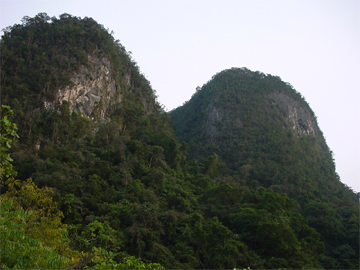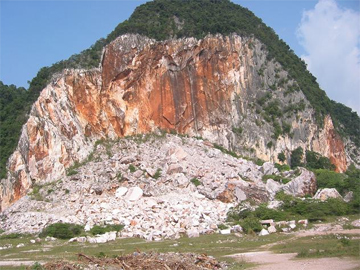Limestone karsts – islands of biodiversity in Asia – under threat from mining
mongabay.com
November 10, 2008
|
|
Researchers have devised a scientific methodology for prioritizing conservation of limestone karsts, biologically-rich outcroppings found in Southeast Asia and other parts of the world. The findings are significant because karsts — formed millions of years ago by sea life — are increasingly threatened by mining and other development.
Using data from 43 karsts across Peninsular Malaysia and Sabah, authors led by Reuben Clements of WWF-Malaysia reported that larger karsts support greater numbers of endemic snails — a proxy for biological uniqueness among other species — making them a priority for protection.
“Larger areas tend to have greater habitat diversity, which enables them so support a higher number of unique species.” said Clements, species conservation manager for WWF-Malaysia.
  Large and pristine limestone karsts in Bau, Sarawak, Malaysia (top), a half-quarried large karst in the Kinta Valley, Perak, Malaysia. Photos by Mr. Reuben Clements. |
With a variety of habitats including sinkholes, caves, cliffs, and underground rivers, and separated from other outcroppings by lowland areas, karsts support high levels of endemism among insects, snails, fish, plants, bats and other small mammals. Animals that inhabit karsts provide humans with important services including pest control, pollination, and a sustainable source of income (swiftlet nests used for bird nest soup, a Chinese delicacy, are found in karst caves). But karsts are increasingly under threat, especially from mining for cement and marble. An earlier study by Clements showed that limestone quarrying is increasing in Southeast Asia by 5.7 percent a year — the highest rate in the world — to fuel the region’s construction boom. The biodiversity of karsts — especially among animals that move to surrounding areas to feed — is also at risk from destruction of adjacent ecosystems, often by loggers or for agriculture.
Clements says the new study, which is published in the November issue of the journal Biological Conservation, will help set conservation priorities for karsts.
 A wave of bats (center of the photo) leaving the large karst chambers of Gunung Mulu National Park, Sarawak, Malaysia. Photo by Mr. Tran Anh Duc. |
“The protection of karsts has been mainly ad hoc and they are usually spared from quarrying by virtue of being situated within state and national parks, or if they possess some form of aesthetic or cultural value,” he said. “Taking Peninsular Malaysia for example, our results suggest that we should set aside larger karsts on both sides of the Titiwangsa mountain range for protection if we want to maximize the conservation of endemic species. Protecting karsts on one side of the mountain chain is not enough.”
“With our findings, we hope that governments would reconsider issuing mining concessions for larger karsts as they tend to be more biologically important,” Clements said.
Citation:
Reuben Clements, Peter K.L. Ng, Xi Xi Lu, Stephen Ambu, Menno Schilthuizen, Corey J.A. Bradshaw. Using biogeographical patterns of endemic land snails to improve conservation planning for limestone karsts. Biological Conservation 141 (2008) 2751-2764.